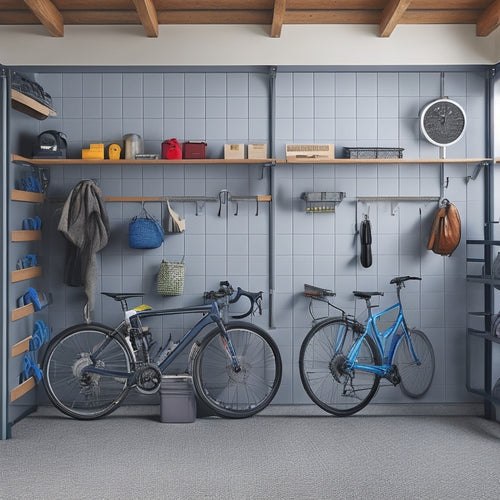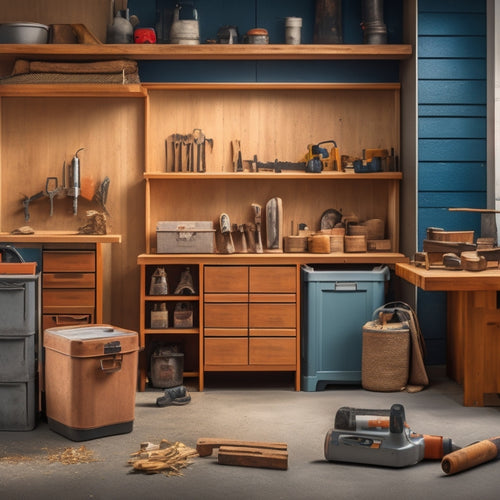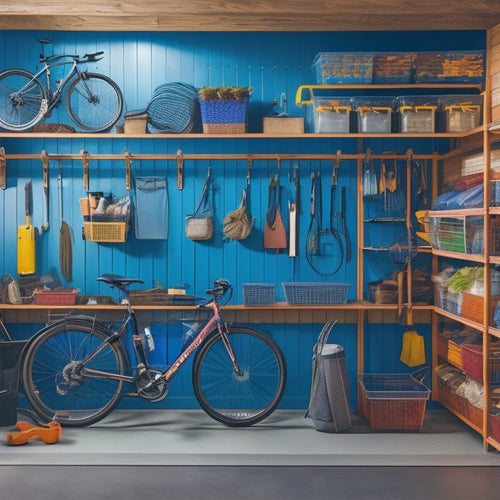
Labelled Organization Storage Bins for Office Use
Share
When you implement labelled organization storage bins in your office, you'll reduce time spent searching for misplaced items, promote accountability among employees, and enhance overall productivity by creating a clear and organized workspace. To get started, evaluate your storage needs to determine the right bin size, consider the aesthetics and durability of materials like plastic, fabric, or metal, and customize labels to fit your team's specific needs. By optimizing your storage solutions, you'll be able to create a clutter-free space that increases efficiency and streamlines workflows - and that's just the beginning of what you'll find when you investigate the world of labelled organization storage bins for office use.
Key Takeaways
- Labelled storage bins reduce time spent searching for misplaced items, promoting accountability and enhancing overall productivity in the office.
- Choosing the right bin size is crucial, considering storage needs, aesthetics, and organizational psychology to improve focus and reduce distractions.
- Bin size versatility and material selection (plastic, fabric, or metal) maximize storage capacity, durability, and visual appeal while fitting office decor.
- Customizing bin labels for teams and categorizing office supplies by groups (e.g., writing utensils, paper products) streamlines workflows and enhances productivity.
- Color coding, labeling, and efficient shelving systems (vertical, adjustable, mobile) facilitate quick identification of bin contents, reduce wasted time, and boost productivity.
Benefits of Labelled Storage Bins
Exactly how much time do you waste searching for misplaced items in your cluttered storage areas? This wasted time can lead to frustration, decreased productivity, and even safety hazards in the workplace.
By implementing labelled organization storage bins, you can eliminate the stress and danger associated with disorganized storage.
Labelled storage bins provide a clear and concise way to identify what's inside, reducing the time spent searching for specific items. This system also promotes accountability, as employees are more likely to return items to their designated bins. Additionally, colour coding can be used to categorize items, making it even easier to locate what you need.
Ergonomic design is another benefit of labelled storage bins. They can be designed to fit comfortably in your workspace, reducing strain on your body and promoting a safe working environment.
Choosing the Right Bin Size
You'll need to decide whether small, medium, or large bins are right for your storage needs.
To make this decision, you'll want to measure the space where the bins will go and think about what you'll be storing in them.
Consider bins that offer versatility in size, so you can adjust as your storage needs change.
Small, Medium, or Large
When it comes to choosing the right size of labelled organization storage bins, getting it just right is essential to maximizing storage capacity and maintaining a clutter-free space. You don't want bins that are too small, as they'll leave you with cluttered shelves and wasted space.
On the other hand, bins that are too large can be overwhelming and difficult to manage. You need to evaluate the bin aesthetics and how they'll fit into your office decor.
A small bin is perfect for storing small items like paper clips, staples, or pushpins. Medium bins are ideal for storing larger items like files, folders, or office supplies. Large bins are best suited for storing bulky items like printer paper, office equipment, or cleaning supplies.
According to organizational psychology, the right bin size can greatly impact your productivity and focus. When you have a clear and organized workspace, you're more likely to stay focused and avoid distractions.
Measuring Space and Needs
Measuring the space where you plan to store your labelled organization storage bins is vital in determining the right bin size for your needs. This guarantees you optimize your space and make the most of your storage area.
Before selecting a bin size, take the time to evaluate your needs. Reflect on the items you need to store, their size, and how frequently you'll access them. This needs assessment will help you determine the ideal bin size for your office storage.
Here are three key factors to reflect on when measuring your space:
-
Width and depth: Measure the width and depth of the shelf or area where you'll place the bin to verify it fits comfortably.
-
Height clearance: Reflect on the height of the items you'll store and the clearance needed to easily access them.
-
Space constraints: Take note of any obstructions, such as pipes or corners, that may impact the size of the bin you can use.
Bin Size Versatility
With a clear understanding of your space and needs, it's time to investigate bin size versatility. Choosing the right bin size guarantees you're maximizing your storage capacity while maintaining a clutter-free workspace. Contemplate the items you'll be storing and the frequency of access. Larger bins are ideal for infrequently used items, while smaller bins are better suited for daily essentials.
When selecting bin sizes, remember that versatility is key. Look for bins that come in various shapes and sizes to accommodate different items. Rectangular bins are perfect for storing papers and files, while square bins are ideal for holding office supplies.
Don't forget to take into account the bin color and its visibility in your workspace. Brightly colored bins can draw attention to important items, while neutral colors can blend into the background.
Having a range of bin sizes at your disposal allows you to adapt your storage system as your needs change. By mixing and matching different bin sizes and shapes, you can create a customized storage solution that keeps your workspace organized, safe, and efficient.
Popular Materials for Office Bins
You're spoiled for choice when it comes to selecting materials for your office storage bins. With a focus on safety, you'll want to contemplate materials that are durable, eco-friendly, and easy to clean.
Here are three popular materials to contemplate:
-
Plastic: A cost-effective and lightweight option, plastic bins are easy to clean and come in a variety of colors for color coding. Look for bins made from recycled materials for an eco-friendly choice.
-
Fabric: Fabric bins offer a soft, flexible design and can be made from recycled materials. They're a great option for storing items like papers and office supplies.
-
Metal: Metal bins are durable and can withstand heavy use. They're also easy to clean and can be made from eco-friendly materials like recycled aluminum.
When making your selection, contemplate factors like durability, aesthetic appeal, and budget considerations.
You may also want to compare different materials to find the best fit for your office needs.
Customizing Bin Labels for Teams
Customize your bin labels to enhance team efficiency and productivity. By doing so, you'll create a system that's customized to your team's specific needs, promoting a smoother workflow and reducing confusion.
When designing your labels, consider the team collaboration aspect. Involve your team members in the label design process to guarantee everyone is on the same page. This will help identify the most critical information to include on the labels, such as the contents, location, and responsible team member.
Keep your label design clean, clear, and concise. Use a font that's easy to read, even from a distance. Avoid clutter and focus on the essential details.
You can also use color-coding to categorize bins by department, project, or type of supplies.
Storing Office Supplies Efficiently
When storing office supplies efficiently, you'll want to start by categorizing items into groups like writing utensils, paper products, and electronics.
Once you've got your categories, create storage bin labels that clearly identify what's inside each bin.
Office Supply Categories
Organizing office supplies into categories is key to storing them efficiently, as it allows you to group similar items together, making them easier to find and access when needed.
This approach guarantees that you can quickly locate the supplies you need, reducing frustration and increasing productivity.
To get started, categorize your office supplies into the following groups:
-
Writing and Drawing: pens, pencils, markers, paper, notebooks, and other stationery items.
-
Paper and Document Management: files, folders, binders, paper clips, stapler, and tape.
-
Office Essentials: scissors, glue, tape, stapler refills, and other miscellaneous supplies.
Storage Bin Labels
You've sorted your office supplies into categories, now it's time to label your storage bins so you can easily identify what's inside. This step is essential in maintaining an organized workspace and ensuring that you can quickly locate the supplies you need.
When designing your labels, consider the type of supplies being stored and the frequency of use. You can use a simple label design that lists the contents of the bin or create a more detailed label that includes a description of the supplies and the quantity.
Color coding is another effective way to label your storage bins. Assign a specific color to each category of supplies, such as blue for writing utensils or green for paper products. This visual cue will help you quickly identify the contents of each bin, even from a distance.
Additionally, consider adding an image or icon to the label to further reinforce the contents. By taking the time to create clear and concise labels, you'll be able to maintain a safe and efficient workspace where you can focus on productivity rather than searching for lost supplies.
Efficient Shelving Systems
Sort your storage bins onto shelving units that maximize your office space, making it easy to access the supplies you need. By doing so, you'll be able to quickly find what you're looking for, reducing wasted time and increasing productivity.
When selecting shelving styles, consider the following organizational strategies to optimize your storage:
-
Vertical shelving: Ideal for small offices, it makes the most of your ceiling height, keeping frequently used items within easy reach.
-
Adjustable shelving: Allows you to customize the shelf height to fit different sized storage bins, ensuring efficient use of space.
-
Mobile shelving: Provides flexibility, enabling you to reconfigure your storage system as your office needs change.
Labelled Bins for Desk Organization
At your workspace, clutter can quickly accumulate, making it difficult to focus on tasks at hand. This is where labelled bins for desk organization come in handy. By using these bins, you can keep essential office supplies, documents, and paperwork neatly stored and easily accessible. This not only enhances desk aesthetics but also gives you a productivity increase.
You can label each bin according to its contents, such as "Pens and Pencils" or "Important Documents." This way, you can quickly find what you need without having to rummage through a cluttered workspace.
Labelled bins also encourage you to put things back in their designated place, maintaining a sense of order and organization. By keeping your workspace tidy, you can reduce distractions and stay focused on your tasks.
Additionally, labelled bins can help prevent lost or misplaced items, saving you time and reducing stress.
Maintaining a Clutter-Free Workspace
You'll find that maintaining a clutter-free workspace is a lot easier when you make decluttering a daily task.
By setting aside a few minutes each day to tidy up, you'll prevent clutter from building up in the first place.
Additionally, designating specific storage spaces for your labelled bins will help keep your workspace organized and make it easier to find what you need.
Decluttering Daily Tasks
By the end of each day, dedicate 10-15 minutes to decluttering daily tasks, ensuring your workspace remains clutter-free and organized.
This daily habit will help you stay focused and productive, allowing you to tackle tasks efficiently.
To declutter daily tasks, follow these steps:
-
Prioritize tasks: Identify the most critical tasks that need to be completed and tackle them first. This will help you manage your time effectively and reduce stress.
-
Organize paperwork: File away documents and papers that are no longer needed, and recycle or shred unnecessary papers. This will help you avoid clutter and reduce the risk of losing important documents.
-
Update your to-do list: Review your to-do list and remove tasks that are no longer relevant or have been completed. This will help you stay on track and avoid feeling overwhelmed.
Designated Storage Spaces
Establishing designated storage spaces is essential for maintaining a clutter-free workspace, as it guarantees that everything has a home and encourages responsible storage habits. When you assign specific areas for specific items, you'll find it easier to locate what you need and avoid wasting time searching for misplaced documents or supplies.
To create an effective design layout, start by identifying the items you use most frequently and allocate storage spaces accordingly. Consider the flow of your work and the frequency of use when determining the placement of your storage bins. This will help you create an efficient organizational system that streamlines your workflow.
Implementing organizational strategies, such as categorizing and grouping similar items together, will also help you maintain a clutter-free workspace. By designating specific storage spaces for specific categories, you'll be able to quickly identify where items belong and prevent clutter from building up.
With a well-planned design layout and effective organizational strategies, you'll be able to maintain a safe and productive workspace.
Common Office Items to Store
Organize your workspace by storing common office items like paper, pens, and staplers in labelled organization storage bins.
This simple yet effective strategy helps maintain a clutter-free environment, promoting workplace efficiency and office minimalism. By categorizing your office supplies, you can easily locate what you need, reducing time wasted searching for misplaced items.
Some essential office items to store in labelled bins include:
- Stationery: paper, notebooks, folders, and other writing materials
- Desk accessories: pens, pencils, staplers, tape, and scissors
- Electronics: chargers, cables, and batteries for your devices
Labelled Bin Systems for Files
One hundred files scattered across your desk can be overwhelming, but with labelled bin systems for files, you can tame the chaos. By categorizing and storing your files in labelled bins, you'll reduce clutter and increase productivity. This file organization system allows you to quickly locate the documents you need, saving you time and reducing stress.
Labelled bin systems for files are designed to provide easy bin accessibility. You can place frequently used files in bins near your workspace, while less frequently used files can be stored in bins on higher or lower shelves.
This system also helps prevent misfiled or lost documents, as each bin is clearly labelled with its contents. With labelled bin systems, you can maintain a clean and organized workspace, reducing the risk of accidents and promoting a safe working environment.
Maximizing Storage Capacity
Since you've implemented a labelled bin system for files, you're now ready to maximize storage capacity. This is where innovative storage solutions come into play. You want to make the most of your available space, ensuring that every inch is employed efficiently.
To achieve ideal space optimization, consider the following strategies:
-
Use vertical space: Install shelving units or stackable storage bins to take advantage of ceiling height, keeping frequently used items within easy reach.
-
Opt for compact containers: Choose bins with a compact footprint, allowing you to store more items in a smaller area without sacrificing accessibility.
-
Label and categorize: Clearly label each bin and categorize contents to facilitate quick retrieval and reduce clutter.
Frequently Asked Questions
Can Labelled Storage Bins Be Used for Storing Confidential Documents?
When storing confidential documents, you'll want to guarantee secure document organization. You can use labelled storage bins for confidential storage, but make certain they're locked, tamper-evident, and access-controlled to maintain the highest level of security.
Are There Labelled Bins Suitable for Outdoor or Industrial Use?
When you need storage for harsh environments, you'll find bins designed for outdoor durability and industrial capacity, built to withstand extreme temperatures, heavy use, and rough handling, ensuring your precious items remain safe and secure.
Can I Use Permanent Markers to Label My Storage Bins?
Will your carefully crafted labels survive the test of time? You're wise to wonder! When using permanent markers, make sure you choose a high-quality one, and employ techniques like writing on a clean surface and avoiding smudging to secure label longevity.
Are Labelled Storage Bins Compatible With Shelving Systems?
When selecting storage bins for your shelving system, you'll want to ascertain they're compatible. Check the bin dimensions to verify they fit snugly on the shelf, and look for bins specifically designed for shelf compatibility to prevent accidents and maximize space.
Can I Purchase Labelled Storage Bins in Small Quantities?
Ah, the sweet taste of flexibility! You're wondering if you can buy labelled storage bins in small quantities, and the answer is yes, you can! Skip bulk purchasing and opt for custom labeling to suit your unique needs.
Conclusion
You've got your labelled organization storage bins in place, and your office is now a haven of efficiency. But don't stop there! Maintain your clutter-free workspace by regularly tidying up and reassessing your storage needs. Will you be able to find what you need in a snap, or will clutter creep back in? Stay on top of your organization game, and you'll be amazed at how much more you can accomplish in a day.
Related Posts
-

Key Features of a Garage Wall Hanging System
You're looking for a garage wall hanging system that's built to last and adapts to your needs. Look for systems made ...
-

Tool Storage Chests for a More Organized Workspace
You're looking to enhance productivity and reduce stress in your workspace by getting your tools organized, and that'...
-

Garage Wall Storage Ideas to Boost Productivity
You can enhance your garage's productivity by capitalizing on your ceiling height with overhead racks, storing bulky ...


